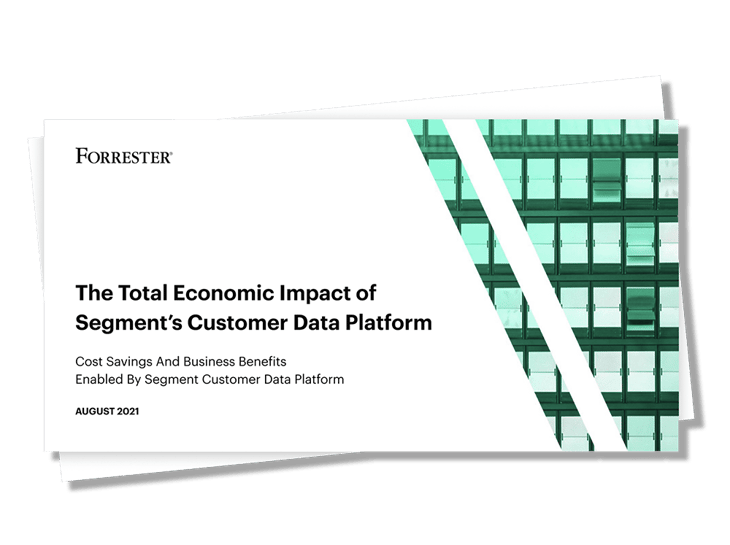Understanding customer attribution across channels and devices continues to be a challenge for Marketers. Customer Data Platforms can have cost savings and can assist you to adapting quickly to new data collection and consumer privacy regulations, and will continue to underpin customer acquisition and retention strategies and enable powerful AI and machine learning capabilities.
But, before investing in a Customer Data Platform it is important that your business audits your current data governance (How your business data is used, who manages it, and who can make decisions about it) and invest in creating a first-party data strategy.
Impact of implementing a CDP
According to Forrester Total Economic Impact Study commissioned by Segment, after adopting a customer data platform their customers saw a 35% reduction in data engineers’ time spent on data management activities.
Customer Data Platforms have allowed our clients to accelerate critical decision making by centralising enterprise and customer-level data to yield more compelling customer engagement strategies.
GBG Loqate 2022 research, shows that consumer data degrades by an average of 15-20% per year, and business data degrades by 30-40% every year.
Customers and prospects move organisations, phone numbers change, and manually entered addresses can linger in the system with formatting errors and spelling mistakes.
Forrester Research found that 37% of marketers waste their budget because of poor data quality.
Features of a CDP
Sitecore CDP has machine learning-powered identity resolution to unify siloed and incomplete customer records so you always know who you’re talking to — and when you shouldn’t be. Once you have comprehensive and accurate profiles for your loyal customers, you can use them to create audience segments and suppress certain ones from specific marketing campaigns.
Exporting the audience to the relevant acquisition channels from within your CDP will ensure you’re not spending your marketing budget chasing after the already-converted customers. This is a great strategy for improving audience targeting.
Our clients are unlocking their business data potential, building deeper customer relationships and making insightful business decisions by connecting their digital ecosystem with our assistance.
"Leaders with the best data practices outperform competitors in every measure of innovation." (Harvard Business Review The State of Cloud-Driven Transformation 2021).
Measuring data quality
Many of our financial services clients are using GBG’s Loqate services to validate in real-time local and global datasets to ensure that the are maintaining data quality and hygiene.
Below lists 5 main criteria that we use to measure data quality:
- Accuracy: for whatever data described, it needs to be accurate.
- Relevancy: the data should meet the requirements for the intended use.
- Completeness: the data should not have missing values or miss data records.
- Timeliness: the data should be up to date.
- Consistency: the data should have the data format as expected and can be cross reference-able with the same results.
Now is the time to take decisive action towards better customer data. Data cleansing is an essential foundation to any data strategy. Speak to our team about building a robust data strategy.
Cost saving outcomes from your customer data platform investment
- Increased operational efficiencies from self-served insights which reduces the time to value. Most CDPs are designed to be user-friendly without the need of a data scientist to interpret the data or use the tool.
- Increase customer profitability. Customer profitability is a measure of the total profit you earn from a particular customer, taking into account both the revenue earned and the costs associated with acquiring the customer and fulfilling their orders.
- Reduce the time it takes to launch campaigns.
- Reduce ad budget waste. High-value audiences are targeted for personalised campaigns, while low-value or churned audiences are suppressed to avoid spending your budget on people who are unlikely to convert.
- Reduce total spend on data analysis software. CDPs often save you money by removing redundant analytics and analysis tools.
Return on investment benchmarks to justify your customer data platform investment
According to Aberdeen Research, CDP businesses outpace non-CDP businesses because integrating data across multiple sources to build a more comprehensive and accurate profile of each customer enables personalised interactions that cater to the unique needs of each buyer. In turn, customers reward these businesses with their loyalty. In fact, the data shows when businesses don't use CDP to build a unified view of the customer, they see an average 6.6% erosion in their client base.
- 9.1x greater annual increase in customer satisfaction rate
- 2.9x greater year on year growth in annual company revenue
- 5.7x greater annual increase in average customer spend
- 4.5x greater annual increase in employee engagement
- 4.9x greater annual growth in cross-sell + upsell revenue
It’s important to remember the above benchmarks represent the average impact of a CDP on business outcomes. These might be different for your business.
3 Tips to maximise your return on investment
- Break down business data silos in your organisation by sharing data & insights. Empowering your employees with self-serve access to customer data is a powerful catalyst for cultural change and innovation.
- Connect as many data points as possible so you can leverage the CDP capabilities. Use this data to drive real-time personalised digital experiences.
- Use data to continuously improve your marketing, sales and help centre performance.
Benefits of a Customer Data Platform
- Build profiles and custom audiences and sync those audiences to advertising, email, A/B testing, chat and other tools in real-time.
- Attain a single view of customers across channels, platforms, and touchpoints, which empowers better business intelligence, customer outreach and informs meaningful engagement strategies.
- Higher Return On Marketing Investment (ROMI) from campaigns as ad targeting is optimised and marketers are able to serve more targeted messaging to prospective customer segments.
- Improve Data Governance.
- Collect, clean, structure and manage your customer data in one place in real-time.
- Understand and stitch together the full user journey.
- Prove your direct impact on the business with powerful attribution modelling.
- Decrease churn rate with streamlined service delivery. When an user interacts with a customer service touchpoint, a staff member can quickly respond with context to the user as CDPs allow you to centralise data, identify who they are, detail their purchase history and any relevant conversations they’ve had with your business.
Our customers who are leveraging CDPs are developing deeper relationships with customers and are serving them with context via personalised content at the right time in their user journey.
Data is the fuel for the future of Digital Experience Platforms. When you can connect the data across the value chain, you can act on insights with confidence and consistently deliver dynamic personalisation at scale across channels. Data and insight technologies in the future will continue to help you to deliver exceptional experiences while respecting changes in privacy and cookies.
Access the Forrester The Total Economic Impact of Segment's Customer Data Platform to evaluate the potential financial impact of a Customer Data Platform could have on your organisation.
Forrester Total Economic Impact of Segment's Customer Data Platform





